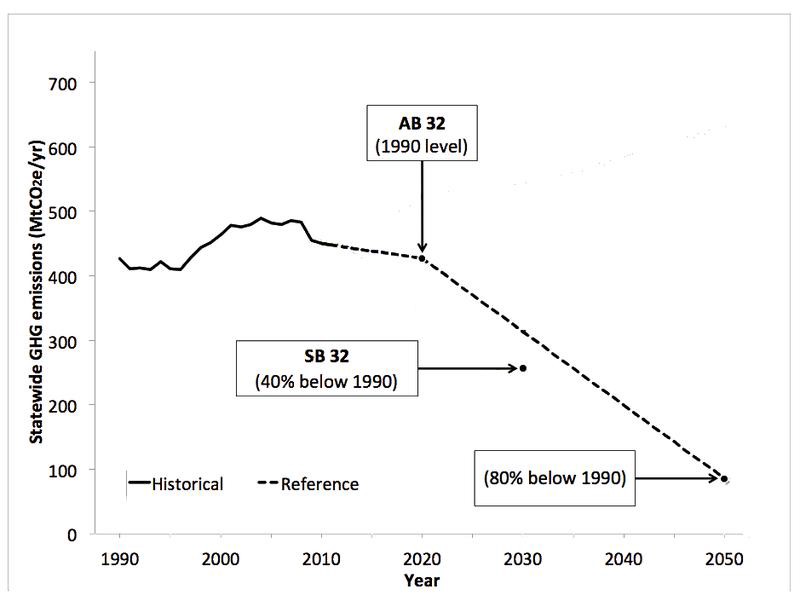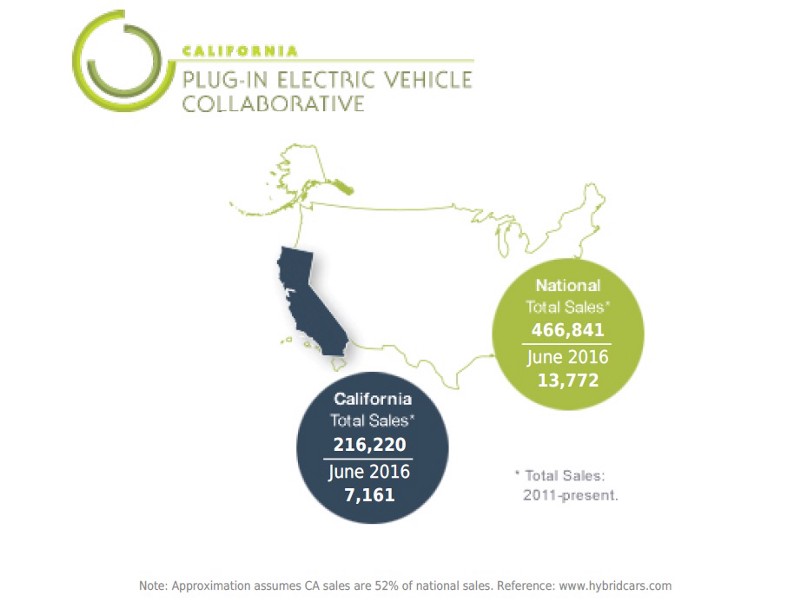California’s SB 32 will require carbon-cutting measures far beyond what the state has achieved to date. But the success of California’s existing climate policies in reducing emissions while achieving robust economic growth provides a strong starting point.
Today, California Governor Jerry Brown signed into law a sweeping new climate law — SB 32 — that establishes ambitious new targets for reducing the state’s carbon emissions through 2030.
The significance of the passage of this law can hardly be overstated. SB 32, passed by the California legislature the last week of August, will require that the state cut its greenhouse gas emissions to 40% below 1990 levels by 2030.
This will be no easy feat. According to a 2015 analysis, it will require inclusion of many new approaches for cutting emissions, in addition to the expansion of renewable energy, electric vehicles, and energy efficiency measures where California is already leading the way.
However, while the targets established by SB 32 are very bold, California is building upon a long track record of impressive climate policies — policies that have been a boon for the state’s economy and Californians’ quality of life.
As the state is poised to dramatically ramp up its climate action, it’s worth looking back at the impact of California’s climate policies to date:
AB 32: The Global Warming Solutions Act
Until now, the centerpiece of California’s climate policies has been the Global Warming Solutions Act, or AB 32. AB 32 helped launch the state’s transition to a low-carbon economy and was one of the first programs in the country to take a comprehensive, long-term approach to addressing climate change. Signed by Governor Schwarzenegger in 2006, it required steep reductions in carbon emissions: to 1990 levels by the year 2020, 15% below projected business-as-usual emissions.
The California Air Resources Board, tasked with implementing the law, established a market-based cap-and-trade system for greenhouse gas emissions. While industry groups have denounced the law as bad for business, a 2016 study by Environmental Entrepreneurs (E2) found that it had significant economic benefits. The analysis found that AB 32 generated about 500,000 jobs and resulted in the injection of $48 billion into the state economy over the past decade, through investments in renewable energy, energy efficiency, transportation and other climate projects.
E2 determined that all of the state’s 80 Assembly districts had benefited. For example, Assembly District 63, southeast of Los Angeles, received $155 million in documented, in-district investment in renewable energy, energy efficiency, transportation and other climate projects, creating nearly 4,000 new local jobs and achieving GHG reductions equivalent to taking 1,900 cars off the road. Assembly District 31, which is west of Fresno, received $1.2 billion in climate project investments, generating more than 2,300 jobs. Resulting emissions cuts were equivalent to eliminating more than 92,000 automobiles.

This chart shows California’s historical emissions and targets established under AB 32 and SB 32. [Photo credit: Vox, adapted from Greenblatt, 2015]
California’s Renewable Portfolio Standard
California’s climate leadership, and its status as the national front-runner in clean energy, has also been advanced by an increasingly aggressive Renewable Portfolio Standard (RPS). The RPS program was first established in 2002 by Senate Bill 1078, which required that by 2017 utilities procure 20% of energy from renewable sources like solar and wind. In 2006 the deadline for hitting this 20% mark was moved up to 2010, and in 2011 a target of 33% renewable energy was set for 2020. Last October, Senate Bill 350 ramped up the RPS target again — this time requiring utilities to get 50 percent of their electricity from renewable sources by 2030.
Despite the ambitious nature of this goal, the Golden State is already ahead of schedule to achieve this target. The California Energy Commission estimates that nearly 25% of electricity retail sales in 2014 were served by renewable energy sources such as wind, solar, geothermal, and biomass. The three largest investor-owned utilities (IOUs), Pacific Gas & Electric (PG&E), Southern California Edison (SCE), and San Diego Gas & Electric (SDG&E), are currently under contract to procure 37.0%, 36.9%, and 43.1%, respectively, of their electricity from renewables by 2020 — all above the required 33%.
Energy Efficiency
California has also led the way in climate policy with a broad suite of energy efficiency programs. California utilities are required to consider energy efficiency measures as the first option to maintain a sufficient supply of electricity before investing in new power plants. And SB 350 — the same law that established the renewable electricity procurement goal of 50% by 2030 — also requires doubling statewide energy efficiency savings by 2030. In addition to statewide standards for energy efficiency in new homes and appliances, which are regularly updated by the California Energy Commission, California has numerous incentive programs to support energy efficiency improvements. These include the Bright Schools Program and Energy Partnership Program which offer energy audits and energy efficiency technical assistance to schools, local governments and public institutions; the Energy Efficiency Financing Program, a revolving loan fund that provides low-interest loans to schools and public institutions for efficiency upgrades and clean energy projects; and the Clean Energy Jobs Act program (Proposition 39) which provides grant money to local education agencies for energy efficiency upgrades and clean energy projects.
These efficiency policies have provided huge benefits, not just to the environment but to the state economy and the well-being of California residents. NRDC documented that from the 1970s to 2013 the state’s energy efficiency policies saved residents and businesses more than $65 billion. These programs contributed to household electric bills that are 25% lower in California than the national average, and decreased utility bills for millions of low-income households. Energy efficiency has also helped make California’s economy more productive; for every kilowatt-hour of electricity consumed in California, twice as much economic output is generated compared to the rest of the country. All this has been achieved while avoiding the construction of at least 30 power plants, and cutting carbon emissions equivalent to the annual output of 5 million cars.
Cleaner Transportation
Reducing greenhouse gas emissions from transportation, which account for 40% of the state’s emissions, is another key element of California’s leadership on climate change to date. The state has taken steps to expand the use of electric vehicles, reduce the carbon emissions of traditional petroleum-based transportation fuels, and help expand the market for low-carbon alternative fuels like biofuels.
The state’s Zero Emission Vehicle (ZEV) mandate requires a rising percentage of vehicles that automakers sell in California to be either electric vehicles or fuel cell vehicles. While this mandated proportion is just 3% today, it has already played a major role in encouraging major automakers to introduce all-electric vehicles in recent years — as well as providing a powerful incentive for the development of Tesla, the largest manufacturer of exclusively electric vehicles in the country. ZEV sales are required to grow to 16% of the market by 2025, an ambitious but achievable goal that will continue to push innovation from automakers that want to compete in the largest vehicle market in the country.
To support the mass adoption of these ZEVs with consumers, California also offers a variety of incentive programs. The state’s Clean Vehicle Rebate Project provides rebates of up to $6,500 for residents who purchase or lease a new, eligible zero-emission or plug-in hybrid light-duty vehicle. As of September, over 150,000 electric vehicle buyers have benefited. Purchasers of electric vehicles may also benefit from faster commute times as they may qualify for a Clean Air Vehicle Sticker allowing single-occupant use of High Occupancy Vehicle (HOV) lanes. These policies have combined to ensure that more than half of electric vehicle sales in the nation, from 2011 to date, have been in California.

Photo credit: California Plug-In Electric Vehicle Collaborative.
Additionally, California’s Low Carbon Fuels Standard (LCFS) establishes a pathway to reduce the carbon emissions from petroleum-based transportation fuels like gasoline and diesel. Created by Executive Order in 2007, the LCFS requires producers of these fuels to reduce their carbon intensity over time, beginning with a quarter of a percent in 2011 and ultimately requiring a total reduction of 10% by 2020. Like AB 32, the LCFS uses a market-based cap-and-trade program. This allows producers to either develop their own low carbon fuels, or buy credits from other companies that develop and sell low carbon alternative fuels (e.g., biofuels, natural gas or hydrogen). Lifecycle assessment is used to determine the carbon content of fuels, considering emissions at all stages of production, from extraction to final point of sale.
Despite claims that the LCFS would result in fuel shortages and price spikes, the industry is in fact exceeding current standards. Just maintaining performance standards from last year, the industry would be able to meet standards through 2019. And the program has been dramatically successful to date, generating significant carbon emissions savings, reducing health-harming pollutants, and helping to grow the market for cleaner alternative fuels.
The Environmental Defense Fund and the American Lung Association estimate that the LCFS, in conjunction with carbon pollution limits under AB32, has contributed to a savings of $1.6 billion in health-related impacts from air pollution to date. These savings represent the prevention of nearly 90,000 cases of respiratory symptoms, 8,000 cases of asthma-related health issues, and 15,000 lost work days. By 2025, as the use of low-carbon fuels grows, the value of these benefits is expected to grow to $8.2 billion annually.
The LCFS has also helped to grow the alternative fuels market. The value of this market has grown by approximately $650 million since 2011, and the use of alternative fuels grew by 36% — displacing between 1.7 and 2.8 billion gallons of gas and diesel.
—
California has long led the nation (and the world) in the implementation of GHG-cutting measures, and it has done so while growing its economy and improving quality of life for its citizens. Many of California’s climate policies have been models for efforts in other regions. With SB 32, California has shown once again that it is serious about leading the way on climate change mitigation. While achieving the demanding cuts required by this law will be a significant challenge requiring innovation and commitment, California builds upon an impressive legacy that proves that climate responsibility is good for business and human quality of life.
